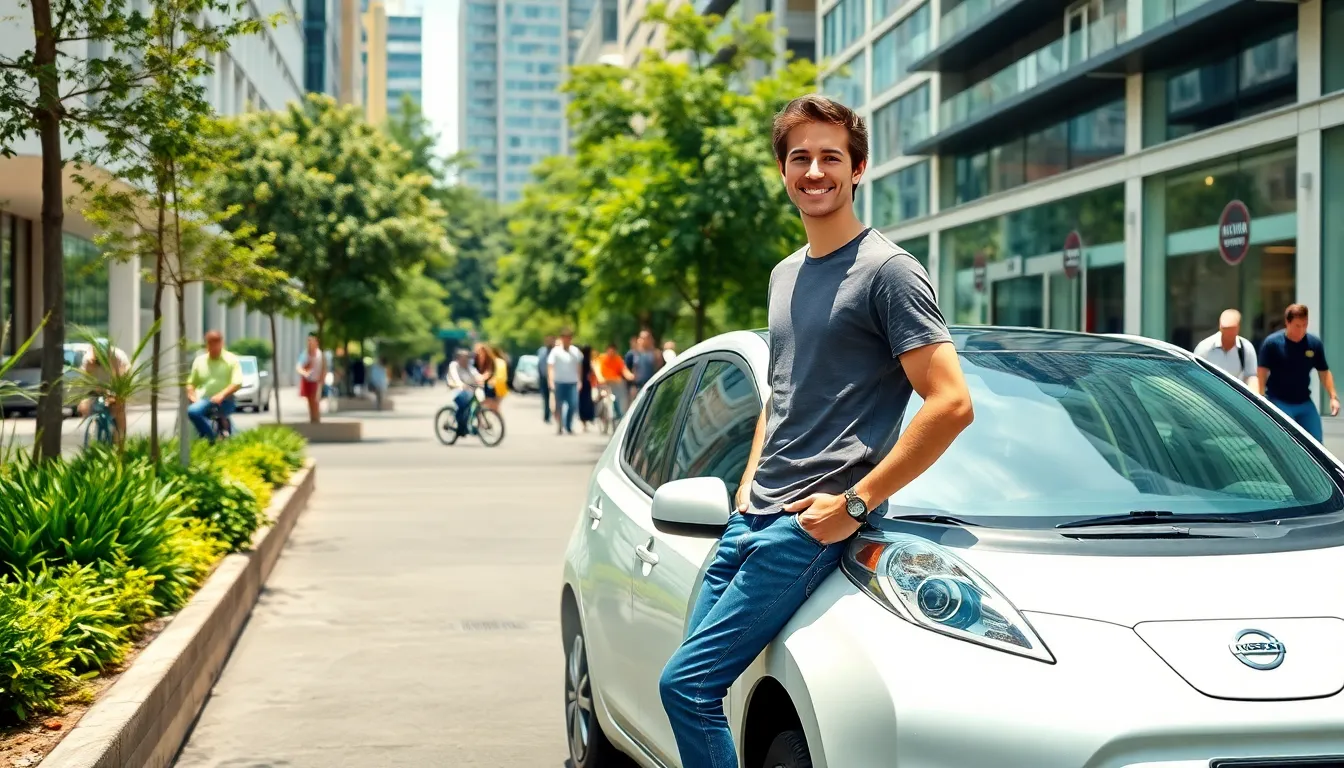We’re witnessing a revolution in urban transportation as small electric cars transform how we navigate city streets. These compact powerhouses combine eco-friendly technology with practical design making them perfect for crowded metropolitan areas where parking’s at a premium and emissions matter more than ever.
Small electric vehicles aren’t just about saving the planet – they’re about saving your wallet too. With rising gas prices and increasing environmental awareness we’re seeing more drivers embrace these efficient alternatives that offer impressive range and surprisingly zippy performance. From sleek two-seaters to versatile city runabouts these cars prove that good things really do come in small packages.
Whether you’re a daily commuter looking to cut costs or an environmentally conscious driver ready to reduce your carbon footprint small electric cars offer the perfect blend of sustainability convenience and style that’s reshaping our roads.
Compact Urban Commuters: City-Friendly Small Electric Cars
Urban environments demand vehicles that excel in tight spaces while delivering zero emission performance. These three models represent the perfect balance of efficiency and practicality for city dwellers.
Nissan Leaf
Nissan’s pioneering electric hatchback continues to dominate the compact EV market with its proven reliability and user friendly design. We’ve found the Leaf particularly appealing for urban commuters who prioritize affordability without sacrificing modern technology features.
The current generation delivers up to 226 miles of EPA estimated range, making it suitable for daily city driving and occasional longer trips. Its compact 175.3 inch overall length allows easy parking in tight urban spaces while maintaining comfortable seating for five passengers.
Technology integration includes ProPILOT Assist for highway driving, NissanConnect infotainment system, and e-Pedal one pedal driving functionality. These features enhance the urban driving experience by reducing driver fatigue during stop and go traffic situations.
Chevrolet Bolt EV
Chevrolet’s entry into the small electric car segment offers impressive range capabilities wrapped in a practical crossover inspired design. We appreciate how the Bolt EV maximizes interior space even though its compact 164 inch length footprint.
Range performance reaches up to 259 miles on a single charge, positioning it among the longest range options in the small electric car category. The elevated seating position provides better visibility in urban traffic while maintaining the maneuverability benefits of a compact vehicle.
Interior versatility shines through its configurable cargo space and smartphone integration capabilities via Chevrolet Infotainment 3 system. DC fast charging capability enables 100 miles of range in approximately 30 minutes, making it practical for urban dwellers without home charging access.
BMW i3
BMW’s distinctive carbon fiber bodied electric car represents the premium end of the compact urban commuter spectrum. We recognize the i3’s unique approach to sustainable transportation through its use of recycled materials and innovative lightweight construction.
The most recent models offered up to 153 miles of electric range before BMW discontinued the model in 2022. Its narrow 69.9 inch width and tight 32.3 foot turning radius made it exceptionally maneuverable in congested city streets and narrow parking spaces.
Design elements like rear hinged doors, minimalist interior aesthetics, and sustainable material choices created a distinctive ownership experience. The optional range extender engine provided additional flexibility for longer urban area trips while maintaining primary electric operation for daily commuting needs.
Budget-Friendly Options: Affordable Small Electric Cars Under $30,000
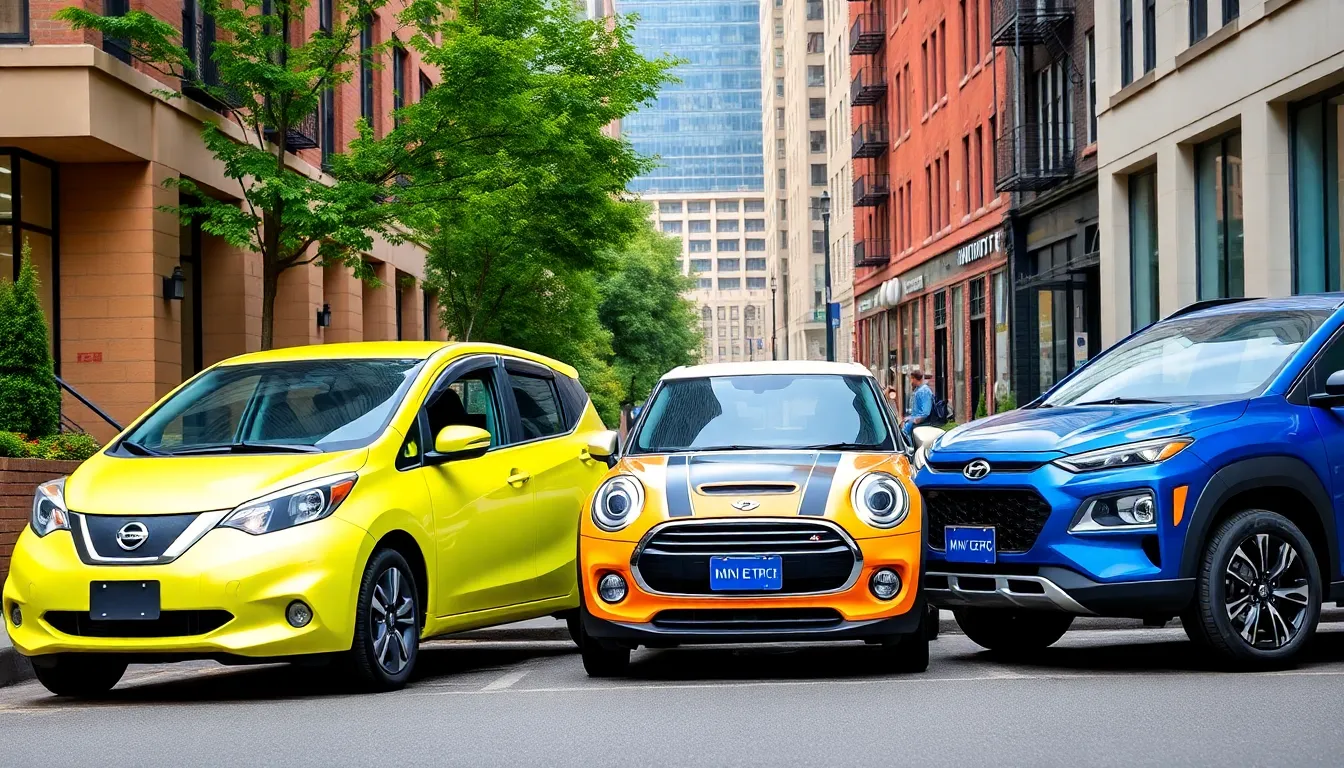
Finding an electric vehicle that delivers both performance and value doesn’t require very costly. We’ve identified several compelling options that prove small electric cars can be both affordable and feature-rich.
Nissan Versa Note Electric
Starting at approximately $27,400, the Nissan Versa Note Electric delivers exceptional value for budget-conscious drivers seeking urban efficiency. This compact electric vehicle offers 150 miles of EPA-estimated range, making it ideal for daily commuting and city errands.
Interior space maximizes passenger comfort with seating for five adults and 18.4 cubic feet of cargo space. We appreciate how Nissan designed the cabin to feel spacious even though the car’s compact footprint. Advanced safety features include automatic emergency braking, blind spot warning, and rear cross traffic alert as standard equipment.
Charging capabilities support both Level 1 and Level 2 charging, with the ability to reach 80% capacity in approximately 40 minutes using DC fast charging. Standard features include an 8-inch touchscreen, Apple CarPlay, Android Auto, and Nissan’s intelligent mobility suite.
Mini Cooper SE
Priced starting at $29,900, the Mini Cooper SE combines iconic British styling with modern electric performance in our most entertaining budget option. This two-door electric vehicle produces 181 horsepower and 199 lb-ft of torque, delivering spirited acceleration perfect for urban adventures.
Range extends up to 114 miles on a single charge, which suits most city drivers’ daily needs perfectly. We love how the Cooper SE maintains Mini’s signature go-kart handling while adding instant electric torque for quick launches from traffic lights.
Premium interior features include sport seats, ambient lighting, and Mini’s intuitive infotainment system with wireless smartphone integration. Standard equipment covers heated front seats, dual-zone automatic climate control, and a panoramic sunroof that enhances the open-air driving experience.
Hyundai Kona Electric
Starting at $29,200, the Hyundai Kona Electric stands out as our top value pick with an impressive 258-mile EPA range that rivals much more expensive electric vehicles. This subcompact SUV design provides higher seating position and better visibility than traditional small electric cars.
Technology package includes Hyundai’s Blue Link connected services, 8-inch touchscreen display, and comprehensive smartphone integration. We particularly appreciate the vehicle’s ability to precondition the cabin remotely, ensuring optimal comfort before entering.
Warranty coverage extends to 10 years or 100,000 miles on the electric powertrain, providing exceptional peace of mind for budget-conscious buyers. Standard features cover automatic emergency braking, lane keeping assist, and driver attention warning systems that enhance safety without increasing the price.
Luxury Compact Models: Premium Small Electric Cars With High-End Features
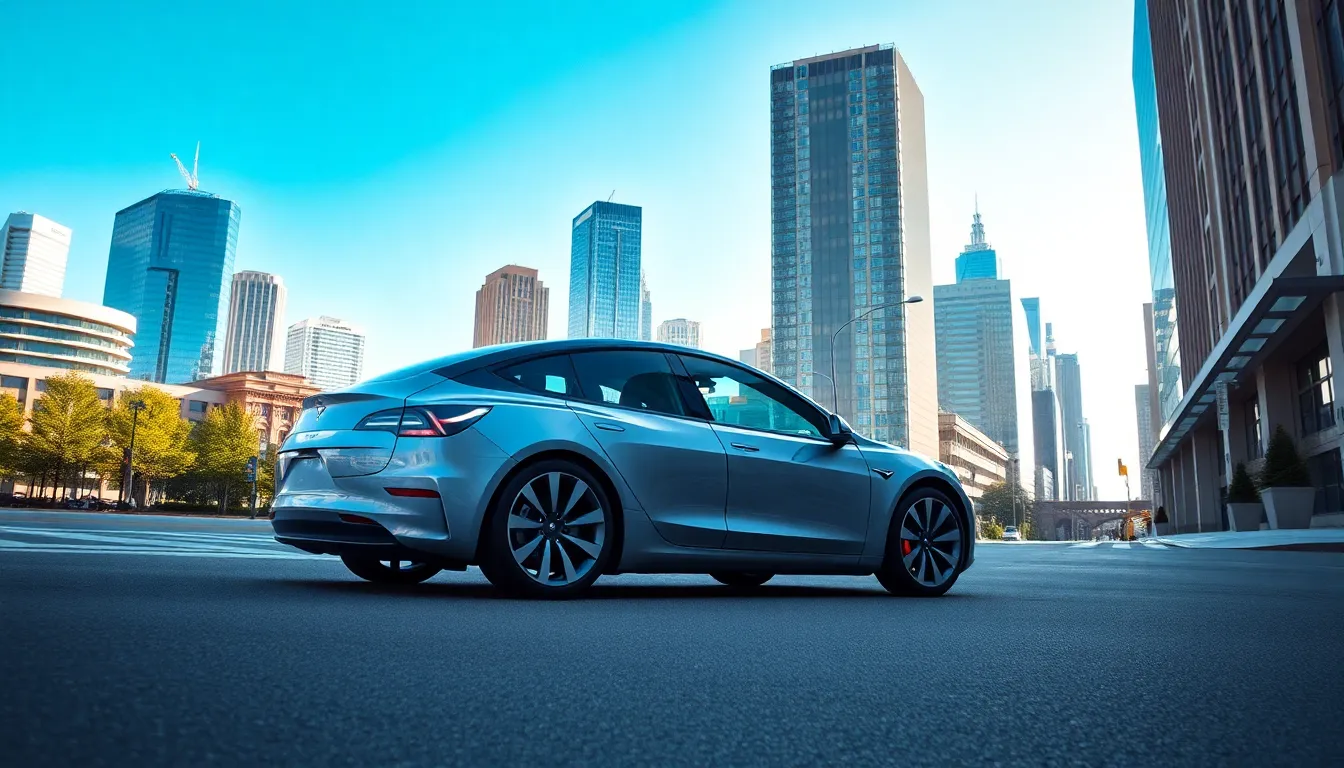
Moving beyond budget options, luxury compact electric vehicles offer sophisticated technology and premium materials that elevate the urban driving experience. These high-end models demonstrate how small electric cars can deliver both luxury and sustainability without compromising on performance or style.
Tesla Model 3
Tesla Model 3 represents the gold standard in luxury compact electric vehicles, offering cutting edge technology and impressive performance capabilities. Starting at $40,240, this four door sedan delivers up to 358 miles of EPA estimated range with the Long Range variant. Tesla’s Autopilot system provides advanced driver assistance features, while the minimalist interior centers around a 15 inch touchscreen that controls virtually every vehicle function.
We appreciate the Model 3’s instant acceleration, with the Performance variant reaching 0 to 60 mph in just 3.1 seconds. Over the air software updates continuously enhance the vehicle’s capabilities, adding new features and improving existing systems. The premium interior features vegan leather seating, glass roof, and a sophisticated sound system that creates an elevated driving environment.
Supercharger network access gives Model 3 owners unmatched charging convenience, with over 50,000 Superchargers worldwide. Tesla’s mobile connector and home charging answers make daily charging effortless for urban dwellers.
Audi e-tron GT
Audi e-tron GT showcases German engineering excellence in a stunning four door coupe design that commands attention on city streets. Priced from $106,500, this luxury electric vehicle combines 469 horsepower with sophisticated all wheel drive capability. The premium cabin features diamond quilted leather seats, Bang & Olufsen sound system, and Virtual Cockpit Plus with customizable displays.
Performance enthusiasts love the e-tron GT’s 3.3 second sprint to 60 mph and its precisely tuned adaptive air suspension system. Audi’s quattro electric all wheel drive distributes power intelligently between front and rear axles for optimal traction. The vehicle’s 238 mile EPA range handles daily urban commutes while 270 kW fast charging capability enables rapid energy replenishment.
Matrix LED headlights and OLED taillights create distinctive lighting signatures that enhance both visibility and style. Premium materials throughout the cabin include sustainable options like recycled plastic components and responsibly sourced leather alternatives.
Polestar 2
Polestar 2 delivers Scandinavian minimalism and Google built infotainment in a compact luxury package starting at $48,400. This five door fastback produces 408 horsepower in Performance Pack configuration, achieving 0 to 60 mph in 4.2 seconds. The EPA rated 270 mile range makes this luxury compact ideal for both daily commuting and weekend adventures.
Google Automotive Services integration provides native Google Maps, Google Assistant, and Google Play Store access directly through the 11.15 inch touchscreen. WeaveTech upholstery and sustainable interior materials reflect Polestar’s commitment to environmental responsibility. Pilot Assist technology offers semi autonomous driving capabilities that reduce fatigue during urban traffic situations.
Brembo brakes and Öhlins dampers in the Performance Pack enhance handling dynamics for enthusiastic drivers. The panoramic glass roof creates an airy cabin atmosphere while maintaining the vehicle’s sleek exterior proportions. Standard all wheel drive and advanced traction control systems ensure confident performance across various road conditions.
Performance-Oriented Small Electric Cars: Speed Meets Efficiency

Performance electric vehicles prove that small size doesn’t mean sacrificing power or excitement. We’ve identified three standout models that deliver impressive acceleration while maintaining the efficiency benefits that make electric driving so appealing.
Porsche Taycan
Porsche Taycan redefines what we expect from compact luxury electric vehicles with its race-inspired engineering. This four-door sports sedan accelerates from 0-60 mph in just 2.6 seconds in its Turbo S variant, delivering 750 horsepower that rivals traditional supercars. We appreciate how the Taycan’s two-speed transmission optimizes both launch performance and highway efficiency, something most electric vehicles can’t achieve.
The vehicle’s 800-volt architecture enables ultra-fast charging speeds up to 270 kW, allowing drivers to add 60 miles of range in just four minutes. Range varies from 200 to 227 miles depending on the configuration, though the focus clearly emphasizes performance over maximum efficiency. Interior appointments include premium leather surfaces, carbon fiber accents, and Porsche’s advanced infotainment system that integrates seamlessly with smartphone connectivity.
BMW i4 M50
BMW i4 M50 combines the brand’s M performance heritage with electric efficiency in a compact four-door coupe design. This model produces 536 horsepower and reaches 60 mph in 3.7 seconds, showcasing how electric motors can deliver instant torque for thrilling acceleration. We find the i4 M50’s 270-mile EPA range particularly impressive for a performance-focused electric vehicle.
The car features BMW’s signature kidney grille design adapted for electric cooling needs, while the interior showcases the latest iDrive 8 infotainment system with a curved display spanning the dashboard. Adaptive M suspension provides precise handling characteristics that honor BMW’s driving dynamics reputation. Fast charging capabilities support up to 200 kW DC charging, enabling 10-80% battery replenishment in approximately 31 minutes.
Genesis GV60
Genesis GV60 represents the luxury brand’s first dedicated electric platform vehicle, combining crossover practicality with sports car performance. This compact SUV delivers 429 horsepower in its Performance trim and accelerates to 60 mph in 4.0 seconds, proving that family-friendly vehicles can still provide excitement. We particularly value the GV60’s 248-mile range that doesn’t compromise significantly for its performance capabilities.
The vehicle introduces innovative features like facial recognition entry and fingerprint ignition, while the interior showcases sustainable materials including recycled ocean plastics. Its biometric technology eliminates the need for traditional keys, adding convenience to the luxury experience. Charging speeds reach up to 350 kW on compatible DC fast chargers, though real-industry speeds typically achieve around 235 kW for optimal battery health management.
Extended Range Champions: Small Electric Cars With Longest Battery Life
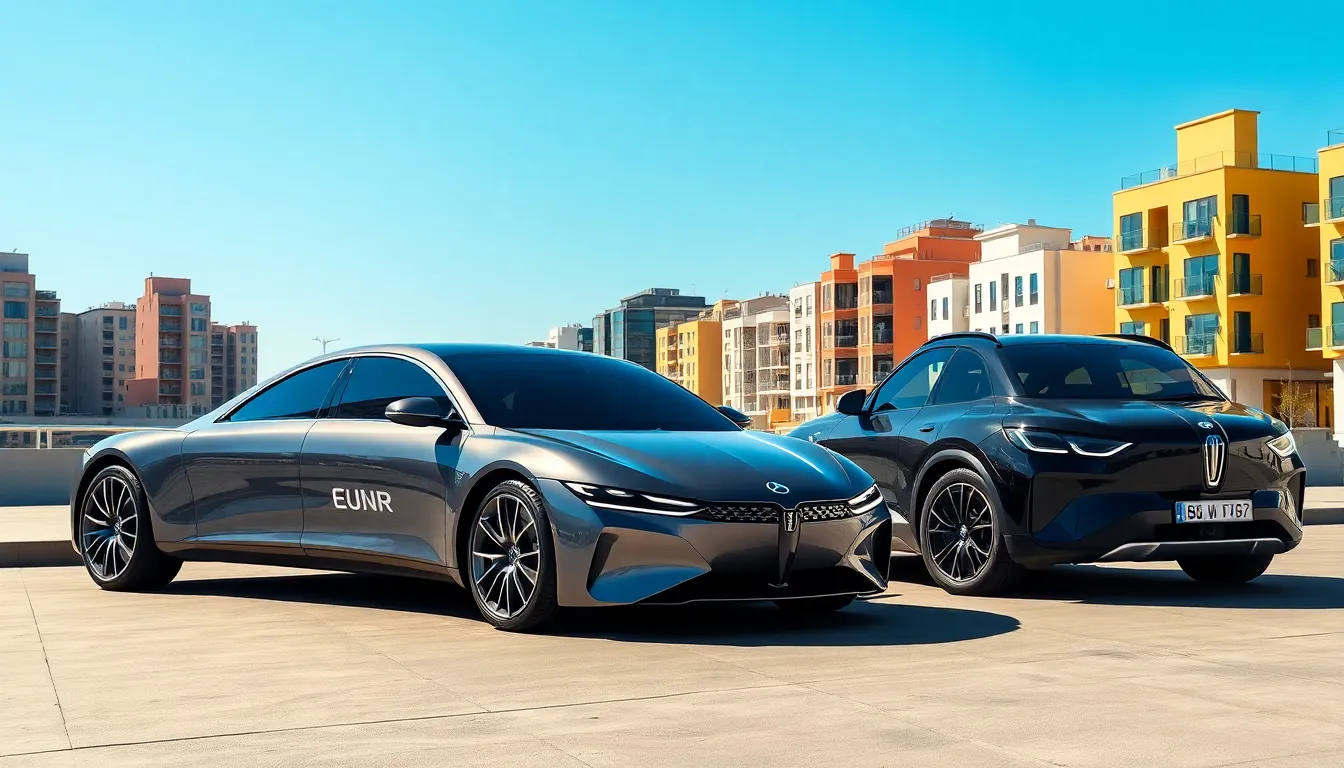
While many small electric cars excel in urban efficiency, some models push the boundaries of range capabilities. These extended range champions prove that compact electric vehicles can deliver impressive battery life for longer journeys.
Mercedes EQS
Range: Up to 453 miles
Battery: 107.8 kWh
Price: Starting at $104,400
Mercedes EQS redefines what we expect from luxury electric vehicles with its industry leading 453 mile EPA estimated range. This aerodynamic sedan achieves remarkable efficiency through its 0.20 drag coefficient and advanced battery management system. We find the EQS particularly impressive because it combines this exceptional range with rapid charging capabilities that can add 300 miles in just 15 minutes at compatible DC fast charging stations.
The vehicle’s sophisticated MBUX Hyperscreen spans nearly the entire dashboard width, providing intuitive control over the car’s advanced features. Mercedes engineers developed the EQS on their dedicated EVA platform, allowing for optimal battery placement and interior space maximization. This thoughtful design results in a quiet, comfortable ride that makes long distance travel effortless.
Lucid Air Pure
Range: Up to 420 miles
Battery: 88 kWh
Price: Starting at $69,900
Lucid Air Pure delivers exceptional range efficiency by achieving 420 miles from its 88 kWh battery pack, setting new standards for energy consumption in the luxury segment. This California based manufacturer engineered their proprietary battery technology to maximize energy density while maintaining safety and longevity. We appreciate how Lucid optimized the Air Pure’s aerodynamics, achieving a drag coefficient of just 0.21 through extensive wind tunnel testing.
The vehicle features Lucid’s advanced motor technology that produces 420 horsepower while maintaining impressive efficiency ratings. Interior space rivals much larger vehicles thanks to the compact electric drivetrain design, offering passengers exceptional comfort during extended drives. Fast charging capabilities allow the Air Pure to add 200 miles of range in approximately 12 minutes at peak charging speeds.
BMW iX3
Range: Up to 324 miles
Battery: 80 kWh
Price: Starting at $55,400
BMW iX3 represents the brand’s commitment to electric SUV efficiency, delivering 324 miles of range in a practical crossover package. This model utilizes BMW’s fifth generation eDrive technology, which integrates the motor, electronics, and transmission into a single compact unit. We find the iX3’s adaptive regenerative braking particularly effective, as it can recover energy during deceleration while maintaining natural pedal feel.
The vehicle’s intelligent thermal management system optimizes battery temperature for both performance and longevity across various driving conditions. BMW’s xDrive all wheel drive system provides confident handling while maintaining efficiency, making the iX3 suitable for both city commuting and longer road trips. Advanced driver assistance features including steering and lane control assist help reduce driver fatigue during extended journeys.
Space-Maximizing Designs: Small Electric Cars With Surprising Interior Room
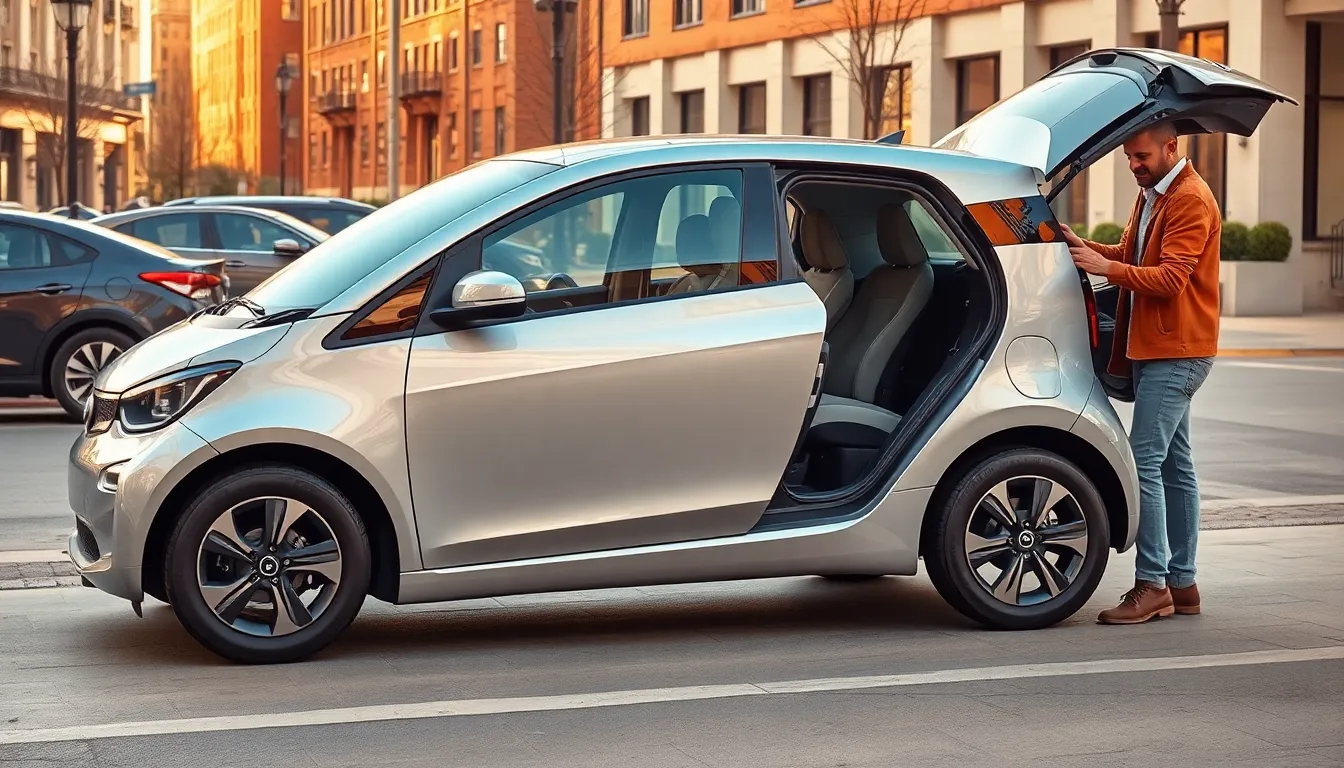
While small electric cars excel in efficiency and urban maneuverability, many models cleverly maximize their interior space to rival larger vehicles. We’ve discovered several compact electric vehicles that demonstrate exceptional space utilization through innovative design and strategic engineering.
Volkswagen ID.4
Interior dimensions showcase impressive space optimization in this compact SUV that offers 99.9 cubic feet of passenger volume. We appreciate how Volkswagen’s MEB platform places the battery pack low in the floor, creating a flat interior surface that maximizes legroom and headroom throughout the cabin. The ID.4 provides 30.3 cubic feet of cargo space behind the rear seats, expanding to 64.2 cubic feet when the second row folds down.
Storage answers throughout the cabin include multiple cup holders, door pockets, and a center console with wireless phone charging. We’ve found the front seats offer excellent support with 12-way power adjustment on higher trims, while the rear bench comfortably accommodates three passengers with ample legroom of 37.1 inches. The panoramic glass roof adds to the spacious feeling without compromising headroom.
Kia EV6
Crossover dimensions deliver exceptional interior versatility with this midsize electric vehicle that provides 106.9 cubic feet of passenger space. We notice the EV6’s dedicated electric platform allows for a completely flat floor, creating more usable space than traditional SUVs of similar exterior size. The vehicle offers 24.4 cubic feet of cargo capacity behind the rear seats and 50.2 cubic feet with seats folded.
Flexible seating arrangements include sliding and reclining rear seats that adjust to prioritize passenger comfort or cargo needs. We appreciate the frunk storage compartment that adds 0.7 cubic feet of additional space for small items. The EV6’s interior width of 58.7 inches provides comfortable shoulder room for five adults, while the high seating position enhances visibility and the perception of space.
Ford Mustang Mach-E
Mustang inspired design maximizes space efficiency in this electric crossover that offers 100.7 cubic feet of passenger volume even though its sporty profile. We’ve observed how Ford’s engineers created a surprisingly roomy interior by optimizing the electric drivetrain packaging and eliminating the traditional transmission tunnel. The Mach-E provides 29.7 cubic feet of cargo space behind the rear seats and 59.7 cubic feet with rear seats folded.
Premium materials enhance the spacious feeling throughout the cabin, with a minimalist dashboard design that creates visual openness. We value the 4.8 cubic foot frunk that provides secure storage for charging cables and personal items. The vehicle’s 15.5 inch vertical touchscreen serves as the command center while maintaining clean interior lines that contribute to the overall sense of spaciousness.
Innovative Technology Features: Small Electric Cars Leading Tech Integration
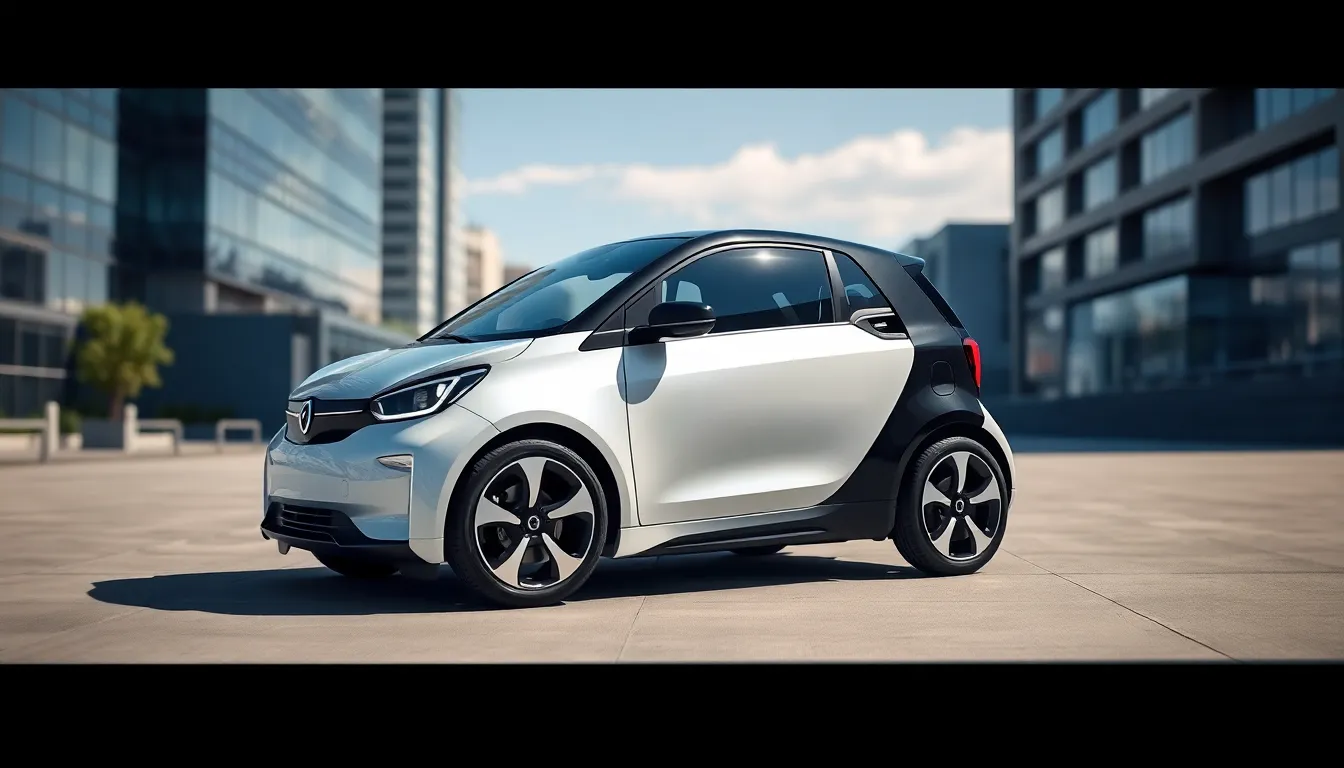
Small electric cars have become the proving ground for cutting edge automotive technology, transforming how we interact with our vehicles and experience urban mobility.
Over-the-Air Updates
Tesla Model 3 revolutionizes vehicle ownership with seamless over the air updates that continuously improve performance and add new features. We’ve seen Tesla owners wake up to enhanced acceleration, improved battery efficiency, and completely new entertainment options without visiting a service center. The system downloads updates automatically while parked, installing them during scheduled maintenance windows to minimize disruption.
Polestar 2 delivers comprehensive software updates that enhance everything from infotainment responsiveness to driving dynamics. The vehicle’s Android Automotive OS receives regular improvements including new apps, interface refinements, and connectivity features. We particularly appreciate how these updates can optimize battery management algorithms, extending range and improving charging efficiency over time.
Volkswagen ID.4 showcases how traditional automakers embrace digital transformation through its sophisticated update system. The vehicle receives monthly improvements to its infotainment system, navigation accuracy, and climate control algorithms. Updates often include new charging station partnerships and enhanced route planning capabilities that make long distance travel more convenient.
Advanced Driver Assistance
BMW i4 M50 integrates Level 2+ autonomous features that handle highway driving with minimal input from the driver. The system combines adaptive cruise control, lane centering, and automatic emergency braking into a cohesive experience. We find the vehicle’s ability to navigate construction zones and handle lane changes particularly impressive during urban commutes.
Genesis GV60 pushes boundaries with its Highway Driving Assist 2 system that maintains safe following distances and centers the vehicle in lanes automatically. The technology includes facial recognition that adjusts seat positions, mirror angles, and climate settings based on the detected driver. Smart cruise control adapts to traffic patterns and can even predict when vehicles ahead will change lanes.
Audi e-tron GT features Traffic Jam Assist that transforms stop and go traffic into a relaxing experience. The system controls acceleration, braking, and steering at speeds up to 37 mph while monitoring surrounding vehicles through multiple cameras and sensors. Predictive efficiency assistant analyzes route data to optimize energy consumption and suggest ideal speeds for maximum range.
Smartphone Integration
Mini Cooper SE offers seamless wireless Apple CarPlay and Android Auto integration that connects automatically when you enter the vehicle. The 8.8 inch touchscreen displays navigation, music, and messaging apps with crisp resolution and responsive touch controls. We appreciate how the system remembers preferred apps and automatically launches your most used navigation or music streaming service.
Hyundai Kona Electric features the Blue Link connected services that transform your smartphone into a comprehensive vehicle control center. The app enables remote start, climate preconditioning, and charging schedule management from anywhere with cellular coverage. Door lock status, battery level monitoring, and theft alerts provide peace of mind when parked in urban environments.
Kia EV6 delivers advanced integration through the Kia Connect app that provides detailed charging station information including real time availability and pricing. The system can precondition the battery for optimal charging speeds before arriving at fast charging stations. Remote climate control lets you heat or cool the cabin while still plugged in, preserving battery range for driving rather than climate management.
Environmental Impact: How Small Electric Cars Reduce Carbon Footprint
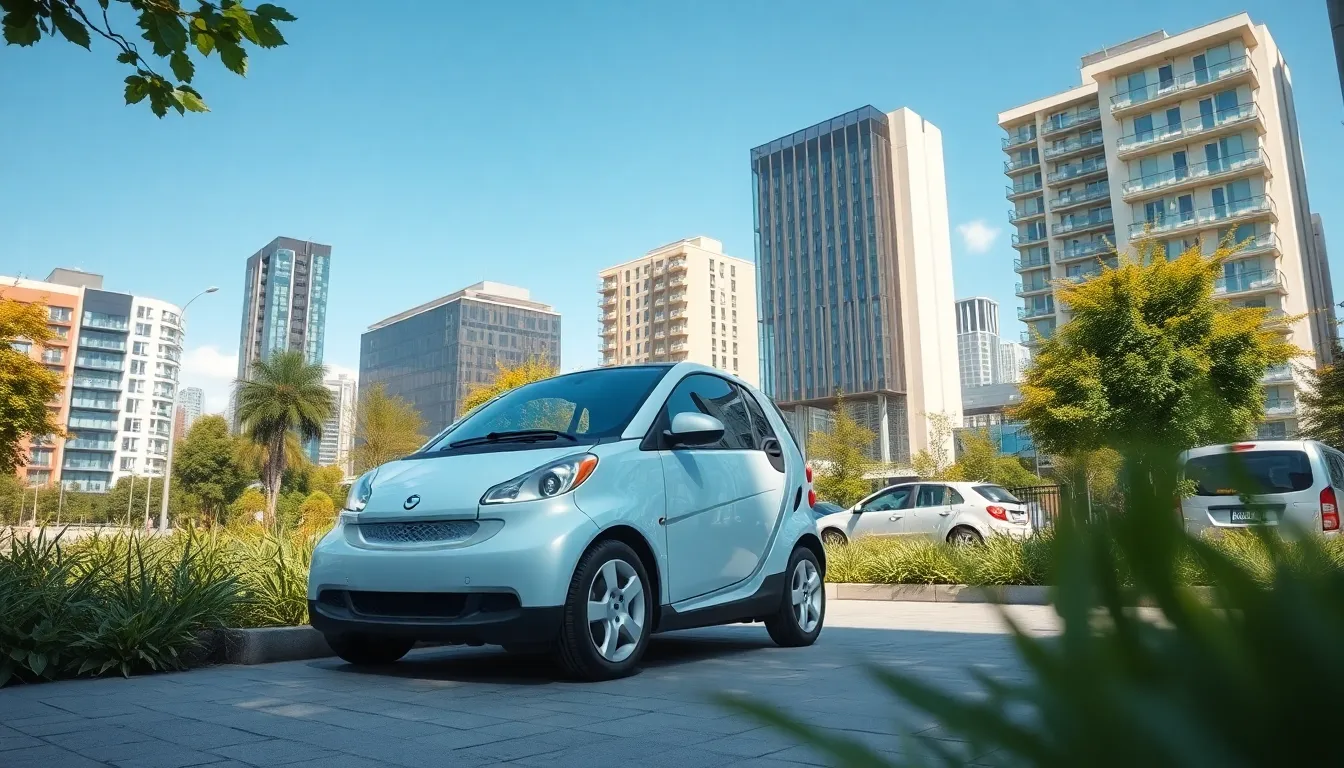
Small electric cars represent a important leap forward in reducing transportation emissions and environmental impact. These compact vehicles deliver measurable environmental benefits that extend far beyond their size.
Zero Direct Emissions
Operating small electric cars produces absolutely no tailpipe emissions during daily driving. Unlike traditional gasoline vehicles that release carbon dioxide, nitrogen oxides, and particulate matter directly into urban air, electric motors generate power without any combustion process.
Studies show that eliminating direct emissions from transportation can reduce local air pollution by up to 40% in dense urban areas. Cities like Oslo and Amsterdam have documented improved air quality measurements following increased electric vehicle adoption. Small electric cars contribute disproportionately to this improvement because they’re primarily used in congested city centers where air quality matters most.
Battery powered vehicles also eliminate secondary pollutants that form when exhaust gases react with sunlight and atmospheric chemicals. This reduction helps decrease smog formation and respiratory health issues in metropolitan areas where small electric cars are most commonly driven.
Renewable Energy Compatibility
Charging small electric cars with renewable energy sources multiplies their environmental benefits exponentially. Solar panels, wind turbines, and hydroelectric power can fuel these vehicles with virtually zero carbon footprint once the infrastructure is established.
Recent data from the International Energy Agency shows that electric vehicles charged with renewable energy produce 70% fewer lifetime emissions compared to gasoline cars. Small electric cars require less energy than larger EVs, making them even more compatible with home solar installations and green energy grids.
Smart charging technology allows these vehicles to automatically charge during peak renewable energy production hours. Many small electric car owners report successfully pairing their vehicles with residential solar systems, achieving near zero operational carbon footprint for their daily commuting needs.
Energy storage capabilities in some models enable owners to use their cars as backup power sources during outages. This vehicle to grid technology helps stabilize renewable energy networks by storing excess clean energy when production exceeds demand.
Sustainable Manufacturing
Manufacturing processes for small electric cars increasingly incorporate recycled materials and sustainable production methods. BMW’s i3 utilized recycled carbon fiber and renewable materials in its construction, setting new standards for eco friendly vehicle production.
Battery recycling programs now recover up to 95% of lithium, cobalt, and nickel from used electric car batteries. Companies like Tesla and Nissan have established closed loop recycling systems that reuse these materials in new battery production, significantly reducing mining requirements.
Smaller battery packs in compact electric cars require fewer raw materials than larger vehicles, reducing the environmental impact of mining operations. A typical small electric car battery uses approximately 30% less lithium and cobalt compared to full size electric SUVs.
Production facilities for many small electric cars now operate on renewable energy sources. Volkswagen’s ID series production facility runs entirely on green electricity, while General Motors has committed to carbon neutral manufacturing for all electric vehicles by 2030.
Cost Analysis: Total Ownership Expenses of Small Electric Cars
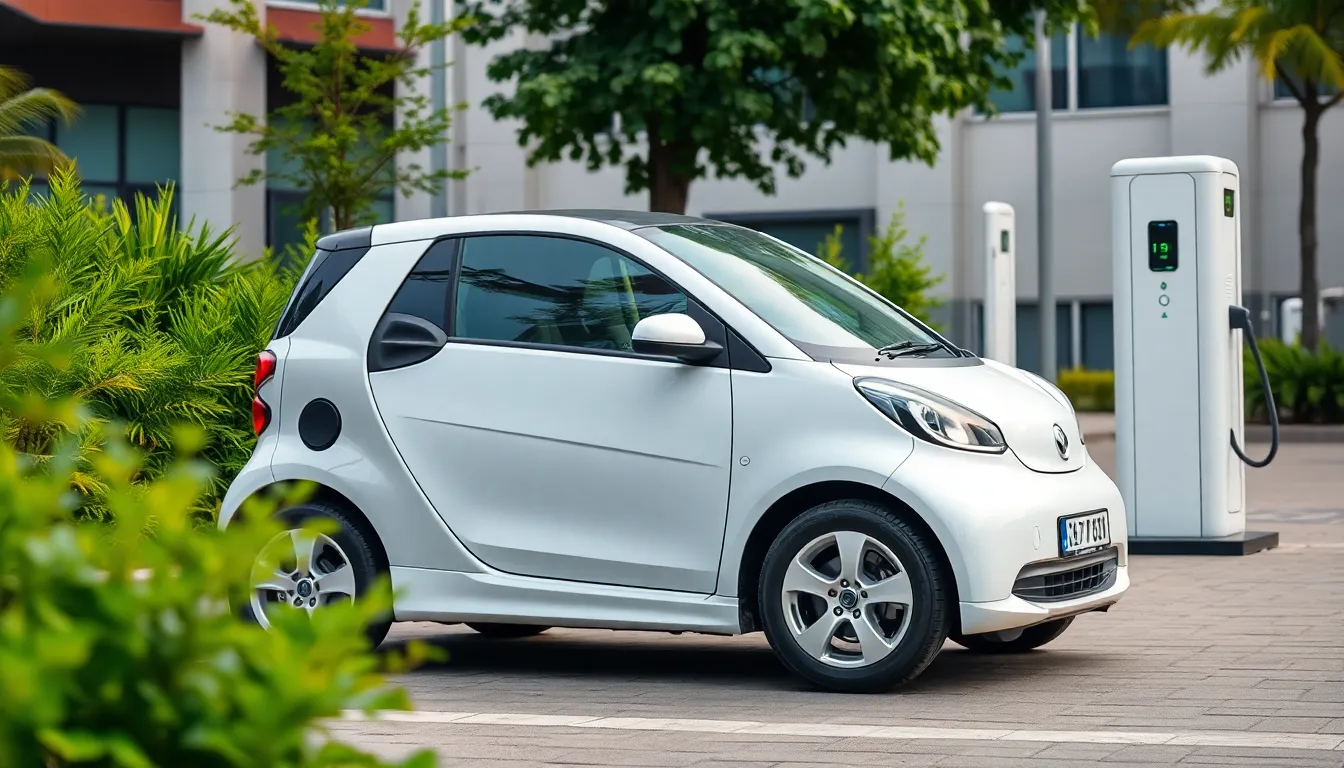
Understanding the complete financial picture helps us make informed decisions when considering small electric cars for urban transportation.
Purchase Price Considerations
Small electric cars typically cost between $27,000 and $45,000 for standard models, positioning them competitively against traditional gasoline vehicles. Federal tax credits up to $7,500 significantly reduce initial investment costs for qualifying models like the Nissan Leaf and Chevrolet Bolt EV. State incentives add another layer of savings, with programs in California, New York, and Colorado offering rebates ranging from $1,500 to $5,000.
Financing options for small electric cars often include manufacturer incentives such as 0% APR for qualified buyers. Leasing presents attractive alternatives with lower monthly payments, particularly for models like the BMW i3 and Mini Cooper SE. Used electric vehicle markets show strong depreciation patterns, creating opportunities for budget-conscious buyers to access premium features at reduced prices.
| Model | Starting MSRP | After Federal Credit | Additional State Incentives |
|---|---|---|---|
| Nissan Leaf | $28,040 | $20,540 | Up to $2,500 |
| Chevrolet Bolt EV | $31,000 | $23,500 | Up to $4,500 |
| Mini Cooper SE | $29,900 | $22,400 | Up to $3,000 |
Maintenance Savings
Electric drivetrains eliminate routine maintenance requirements like oil changes, spark plug replacements, and transmission servicing, reducing annual costs by approximately $400 to $800. Brake systems in small electric cars last significantly longer due to regenerative braking technology, with brake pads typically lasting 75,000 to 100,000 miles compared to 30,000 miles in conventional vehicles.
Cooling systems require minimal maintenance since electric motors generate less heat than internal combustion engines. Battery warranties typically extend 8 years or 100,000 miles, providing peace of mind for major component reliability. Tire wear patterns remain consistent with conventional vehicles, though instant torque delivery may accelerate wear on performance models like the BMW i4 M50.
Service intervals stretch longer for small electric cars, with many manufacturers recommending annual inspections rather than frequent scheduled maintenance visits. Parts availability continues improving as electric vehicle adoption increases, though specialized components may cost more initially.
Fuel Cost Comparisons
Electricity costs average $0.13 per kWh nationally, translating to approximately $0.04 per mile for efficient small electric cars like the Hyundai Kona Electric. Gasoline vehicles averaging 30 mpg cost roughly $0.12 per mile at $3.60 per gallon, creating substantial savings for electric drivers.
Home charging provides the most economical option, with overnight rates in many regions dropping below $0.08 per kWh. Public charging networks vary significantly, with Level 2 stations charging $0.20 to $0.30 per kWh and DC fast charging reaching $0.35 to $0.50 per kWh.
Annual fuel savings typically range from $600 to $1,200 for average drivers covering 12,000 miles yearly. Time-of-use electricity rates maximize savings when we charge small electric cars during off-peak hours. Solar panel installations can effectively eliminate fuel costs entirely, creating energy independence for environmentally conscious drivers.
| Comparison Factor | Small Electric Cars | Gasoline Cars |
|---|---|---|
| Cost per mile | $0.04 | $0.12 |
| Annual fuel cost (12k miles) | $480 | $1,440 |
| Home charging advantage | 40% savings vs public | N/A |
Conclusion
Small electric cars represent the future of urban mobility and we’re witnessing their rapid evolution firsthand. These vehicles have proven they can deliver everything modern drivers need – from impressive performance and luxury features to practical interior space and cutting-edge technology.
The financial benefits make the decision even easier. With lower maintenance costs federal tax credits and important fuel savings small electric cars offer compelling value propositions that extend far beyond their environmental advantages.
We’re confident that small electric cars will continue reshaping how we think about city transportation. Whether you prioritize sustainability performance or simply want a smart financial choice these compact electric vehicles deliver on all fronts while helping create cleaner more livable urban environments for everyone.
Frequently Asked Questions
What makes small electric cars ideal for urban driving?
Small electric cars are perfect for city driving due to their compact size, zero emissions, and quiet operation. They easily navigate narrow streets and tight parking spaces while providing instant torque for quick acceleration in stop-and-go traffic. Their eco-friendly technology helps reduce air pollution in densely populated areas.
How much can I save on fuel costs with a small electric car?
Electric vehicles offer significant fuel savings compared to gasoline cars. On average, electricity costs much less per mile than gasoline, resulting in annual fuel savings of hundreds to over a thousand dollars, depending on your driving habits and local energy rates.
What is the typical range of small electric cars?
Modern small electric cars offer impressive ranges, typically between 150-450 miles on a single charge. Popular models like the Chevrolet Bolt EV provide 259 miles, while luxury options like the Mercedes EQS can achieve up to 453 miles of range.
Are there affordable small electric cars under $30,000?
Yes, several excellent options exist under $30,000, including the Nissan Versa Note Electric ($27,400), Hyundai Kona Electric ($29,200), and Mini Cooper SE ($29,900). These vehicles offer good range, modern features, and quality construction at accessible price points.
How much maintenance do small electric cars require?
Electric cars require significantly less maintenance than gasoline vehicles. They don’t need oil changes, spark plug replacements, or transmission servicing. Annual maintenance savings typically range from $400 to $800, as electric drivetrains have fewer moving parts and less wear.
Do small electric cars have enough interior space?
Despite their compact exterior, many small electric cars maximize interior space through clever design. Models like the Kia EV6 offer 106.9 cubic feet of passenger space, while the Volkswagen ID.4 provides 99.9 cubic feet, rivaling much larger traditional vehicles.
What technology features do small electric cars offer?
Small electric cars lead in technology integration, featuring over-the-air updates, advanced driver assistance systems, smartphone connectivity, and cutting-edge infotainment systems. Many models continuously improve through software updates without requiring service center visits.
How environmentally friendly are small electric cars?
Small electric cars produce zero direct emissions and significantly reduce carbon footprints. When charged with renewable energy, they can achieve a 70% reduction in lifetime emissions compared to gasoline cars. Many manufacturers also use recycled materials and sustainable production methods.
Can small electric cars handle highway driving and long trips?
Modern small electric cars excel at highway driving with ranges exceeding 250+ miles in many models. Fast-charging capabilities allow quick stops during long trips, with some vehicles adding 200+ miles of range in just 10-15 minutes of charging.
What government incentives are available for small electric cars?
Federal tax credits up to $7,500 are available for qualifying electric vehicles, along with various state and local incentives. These can include rebates, reduced registration fees, HOV lane access, and free parking in some cities, significantly reducing ownership costs.

